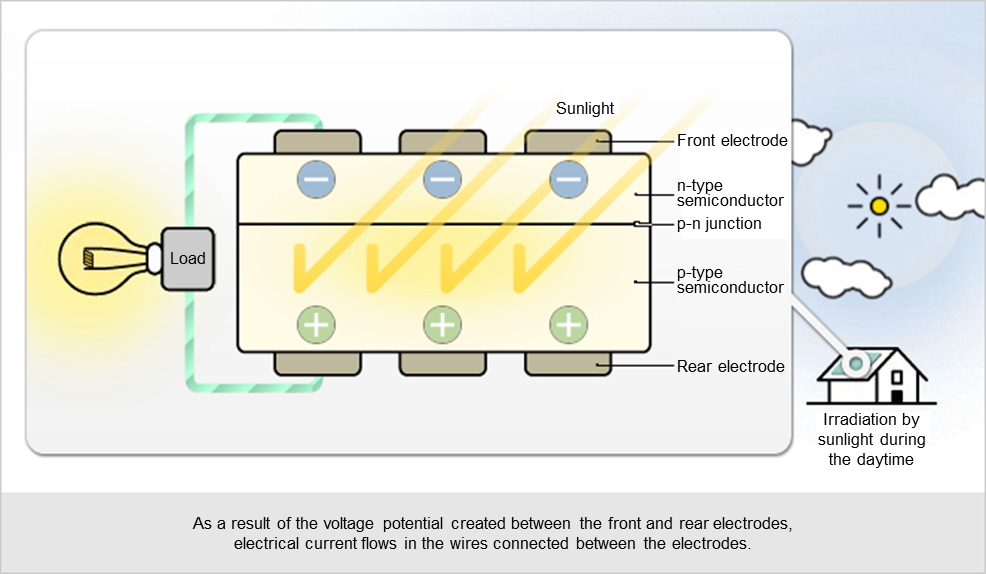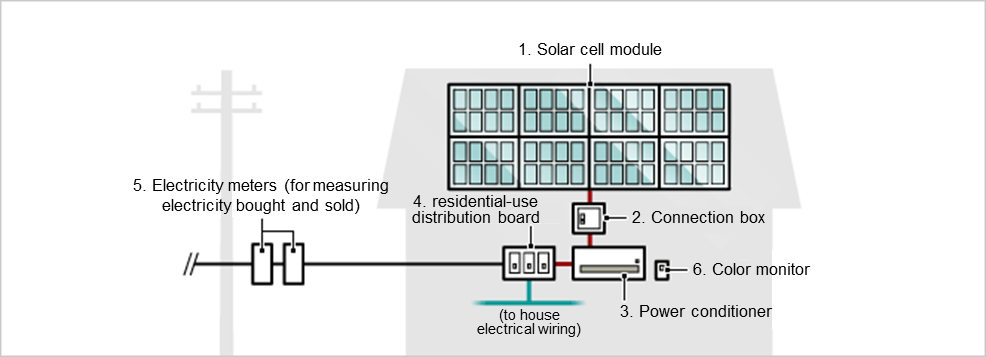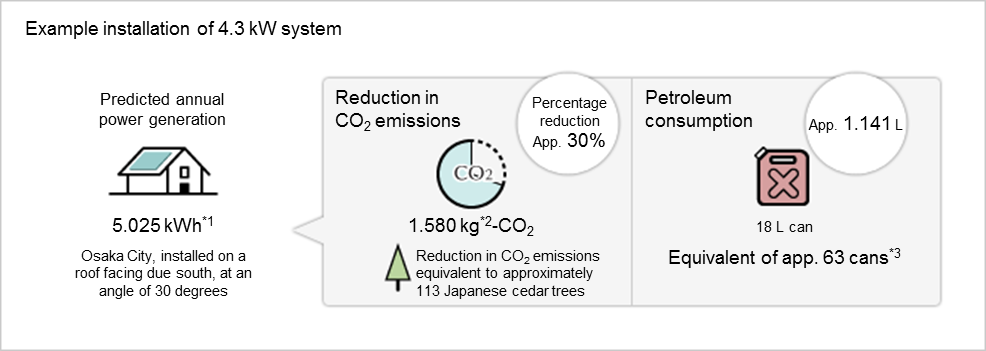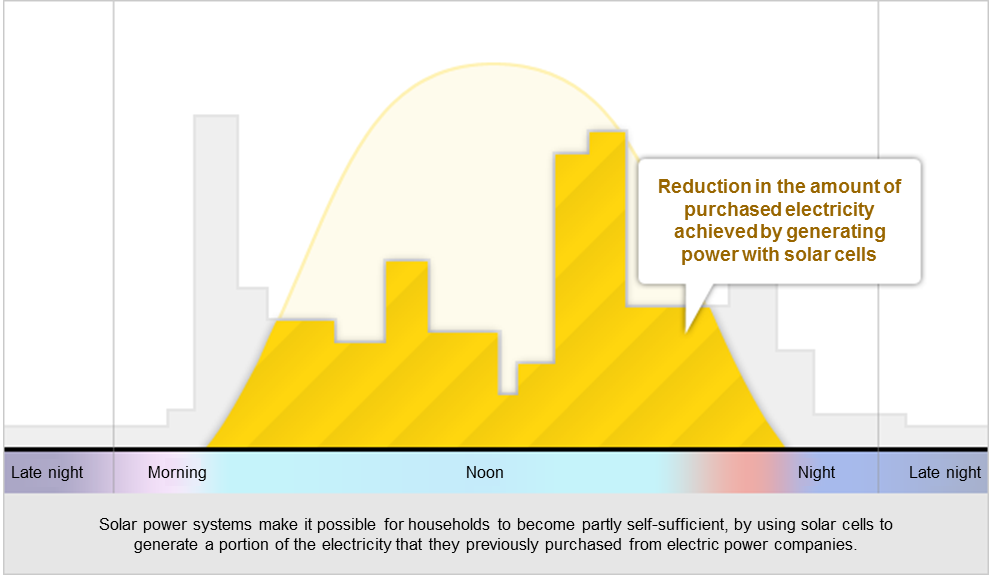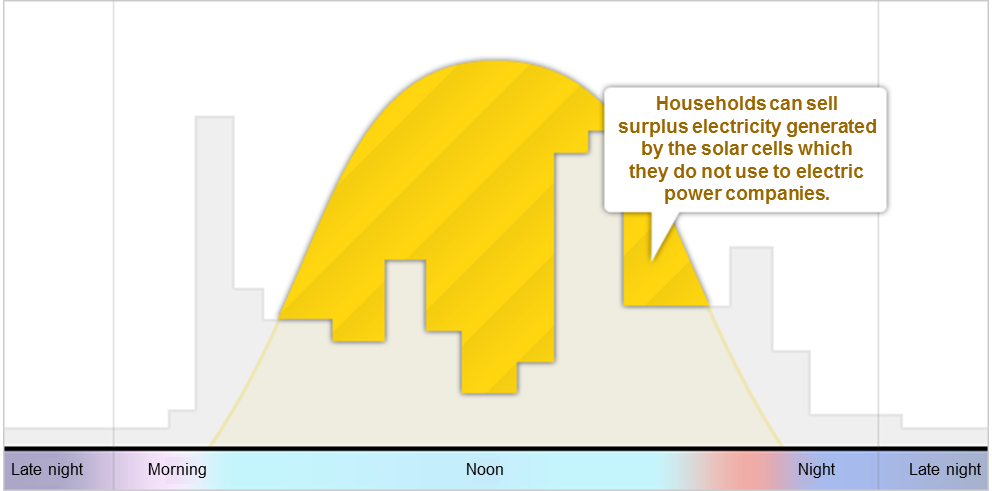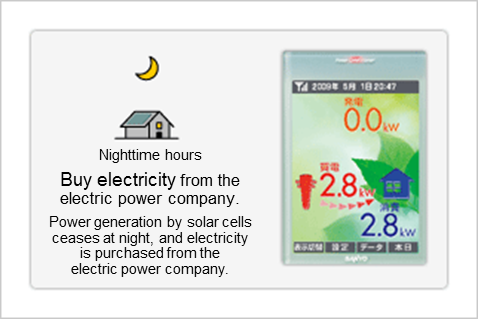Solar Power System
What are Solar Power Systems?
Solar power systems use the energy of sunlight to generate power via solar cells attached to the roofs of houses, etc. Solar power systems have gained attention as environmentally friendly systems, because they use the natural energy of sunlight to generate power, and do not emit CO2, regardless of how much power is generated. Because power companies buy surplus electricity generated in your home, it is also an economically-friendly system.
How do Solar Power Systems Generate Electricity?
Many of the solar cells currently in use are silicon-type solar cells, which adopt a structure in which two types of semiconductors (p-type and n-type) with different electrical properties are arranged in layers. When sunlight shines on the solar cells, it gives rise to negatively-charged electrons (-) and positively charged holes (+). The holes are attracted and drawn towards the p-type semiconductor, while the electrons are drawn towards the n-type semiconductor. When an electrical load—such as a light bulb or motor—is connected between the electrodes on the front and rear surfaces, then an electrical current begins to flow.
Solar Power System Structure
| 1. Solar cell module | Generates direct electrical current (DC) from the energy of the sun’s rays. |
|---|---|
| 2. Connection box | Collects electrical power generated by the solar cells and delivers it to the power conditioner. |
| 3. Power conditioner | Efficiently converts the electrical power sent to it from the connection box into alternating current (AC) power that can be used around the home. Also manages the operation of the entire system. |
| 4. Distribution board | Distributes power sent to it from the power conditioner around the house on a priority basis. Surplus power that cannot be used around the house flows out from the distribution board (in the reverse direction) and is sold to electric power companies. |
| 5. Electricity meters for measuring electricity bought and sold |
Measure the amount of surplus electricity being sold to electric power companies, and the amount being purchased from electric power companies (when the amount of power being generated is insufficient). |
| 6. Color monitor | Enables users to check the state of power generation and the state of power usage around the home, in real-time. |
Advantages of Solar Power Systems
1. Environmental conservation benefits
Solar power systems use the natural energy of sunlight to generate power, and do not emit CO2 regardless of how much power is generated. This means that we can contribute to reducing CO2 emissions simply by installing them in our homes.
*1: According to manufacturer’s power generation simulations.
*2: The amount of CO2 generated was estimated at 0.3145kg-CO2/kWh, also taking the amount of CO2 generated during the production of the solar cells themselves (0.0455kg-CO2/kWh) into consideration.
*3: The amount of petroleum consumed in thermal power generation was calculated at 0.227L per kWh.
2. Reducing the amount of electricity purchased
The electricity generated by solar power systems is used for lights and electrical appliances around the home on a priority basis, enabling reductions in the amount of electricity purchased from electric power companies. Additionally, since typical electricity charges (i.e. purchase prices) become more expensive the more electricity is used, solar power systems offer lots of savings, because they enable households to reduce the amount of electricity they purchase at expensive rates.
Because solar cells cannot generate electricity at night, households purchase electricity from electric power companies in the conventional manner. When doing so, it is possible to save efficiently on electricity charges by using a time-specific electric lighting contract* that makes electricity charges cheaper during the nighttime.
*An electricity tariff system whereby electricity usage is calculated separately for daytime and nighttime. In comparison with regular charges, daytime hours (between 07:00 and 23:00) are charged at a higher rate (30% increase), while nighttime hours (between 23:00 and 07:00) are charged at a cheaper rate (70% off).
3. Selling electricity to electric power companies
Households can sell surplus electric power not used in the home to electric power companies. There are no bothersome procedures or construction work to be carried out, and the exchange of electricity takes place automatically. Electricity charges for the amount of electricity sold are deposited electronically by the electric power company into the customer’s account every month.
4. Improving family awareness of saving energy and conserving the environment
It is possible for households to check the amount of power which they are generating, their electric power usage, and the reduction in CO2 emissions that they are achieving in real time via a monitor. This enables everyone in the family to enjoy working together to save energy and contribute to society.
Daytime hours
Nighttime hours
5. Blocks heat from entering and/or leaving the attic
Installing solar panels on the roof of a house has a heat shielding effect, which enables residents to enjoy cooler summers and warmer winters in their house. Households can also expect to see reductions in utility bills for air conditioners and other appliances.
|
Roof surface temperature
|
Measured temperature of rear/inside of roofing boards
|
Temperature difference
|
|
|---|---|---|---|
|
Module not installed
|
Module installed
|
||
|
Summer: 70°C
|
49.32°C
|
38.4°C
|
-10.92°C
|
|
Winter: -5°C
|
8.12°C
|
13.35°C
|
5.23°C
|
6. Excellent durability
Because solar cell modules have simple structures* and contain no motors or other moving parts, they are able to continue generating power with virtually no maintenance. It is because of this excellent durability that they have been adopted for use in artificial satellites and lighthouses, and continue to make long-term active contributions under harsh environmental conditions.
*Power conditioners have around the same durability as typical electrical appliances.

